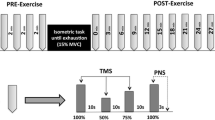Summary
“Diverting activity” is defined as any physical or mental activity performed between or simultaneously with bouts of exhaustive, local muscular work. In the present experiments bouts of exhaustive work consisting of rhythmic lifting of weights were performed with the elbow flexors or with the flexors of the middle finger. Pauses of 2 min duration spent in complete rest or while performing diverting activities alternated between the bouts of work. As diverting activities were used: Physical activity, dynamic or static, performed with big or small muscle groups (other than the fatigued group), or mental activity (problem solving). It was found that the amount of work that could be performed after a pause with diverting activity was always larger than the amount of work performed after a passive pause. The beneficial effect was seen also when the blood flow to the exhausted muscles was interrupted by pneumatic cuffs. Determination of the blood flow in the exhausted muscles by means of Xe-133 clearance showed no systematic blood flow increases caused by the diverting activity. It is concluded that recuperation after local muscle fatigue is influenced by a central nervous factor (Setchenov phenomenon) that is largely independent of the local blood flow.
Similar content being viewed by others
References
Alpert, J. S.: The mechanism of the increased maximum work performance of small muscle groups resulting from “diverting work” with other muscle groups. Acta physiol. scand. 77, 261–271 (1969)
Asmussen, E.: Deflective exercises. T. LegemsØvelser 2, 25–35 (1936) (Danish)
BrØndum-Laursen, J.: Deflective work. T. LegemsØvelser 32, 1–9 (1967) (Danish)
Eklund, B., Kaijser, L.: Effect of regional α or Β-adrenergic blockade on blood flow in the resting forearm during contralateral isometric handgrip. J. Physiol. (Lond.) 262, 39–50 (1976)
Hellebrandt, F. A., Houts, S. J.: Influence of bimanual exercise on unilateral work capacity. J. appl. Physiol. 2, 446–452 (1950)
Lind, A. R., Taylor, S. H., Humphreys, P. W., Kenelly, B. M., Donald, K. W.: The circulatory effects of sustained voluntary muscle contraction. Clin. Sci. 27, 229–244 (1964)
Lind, A. R., McNicol, G. W.: Circulatory responses to sustained hand-grip contractions performed during other exercises, both rhythmic and static. J. Physiol. (Lond.) 192, 595–607 (1967)
Marschak, M. E.: Experimentelle Untersuchungen über den Einflu\ der aktiven Erholung auf die ArbeitsfÄhigkeit des Menschen. Arbeitsphysiologie 6, 664–680 (1933)
Mosso, A.: Die Ermüdung, p. 85. Leipzig: Hirzel 1892
Rosenblat, V. V.: On the possibility of eliciting the Setchenov-phenomenon by conditioned reflexes during static work. Bjult. eksperiment. biologii i mediciny 6, 405–407 (1951) (Russian)
Setchenov, I. M.: Zur Frage nach der Einwirkung sensitiver Reize auf die Muskelarbeit des Menschen. In: Selected works, pp. 246–260. Moscow 1935
Shebeko, M. I.: Cit. in Bulygin, I. A.: On the rhythmic muscle activity in man and its regulation through conditioned reflexes. Zh. vyssh. nerv. Deyat. Pavlova 7, 469–478 (1957) (Russian)
Schneider, W., Jensen, J. T.: Deflective efforts. Special report, pp. 1–113. Laboratory for the Theory of Gymnastics (1971) (Danish)
Weber, E.: Eine physiologische Methode, die LeistungsfÄhigkeit ermüdeter menschlicher Muskeln zu erhöhen. Arch. Physiol. (Leipzig) 1914, 385–420
Author information
Authors and Affiliations
Rights and permissions
About this article
Cite this article
Asmussen, E., Mazin, B. Recuperation after muscular fatigue by “diverting activities”. Europ. J. Appl. Physiol. 38, 1–7 (1978). https://doi.org/10.1007/BF00436747
Accepted:
Issue Date:
DOI: https://doi.org/10.1007/BF00436747




